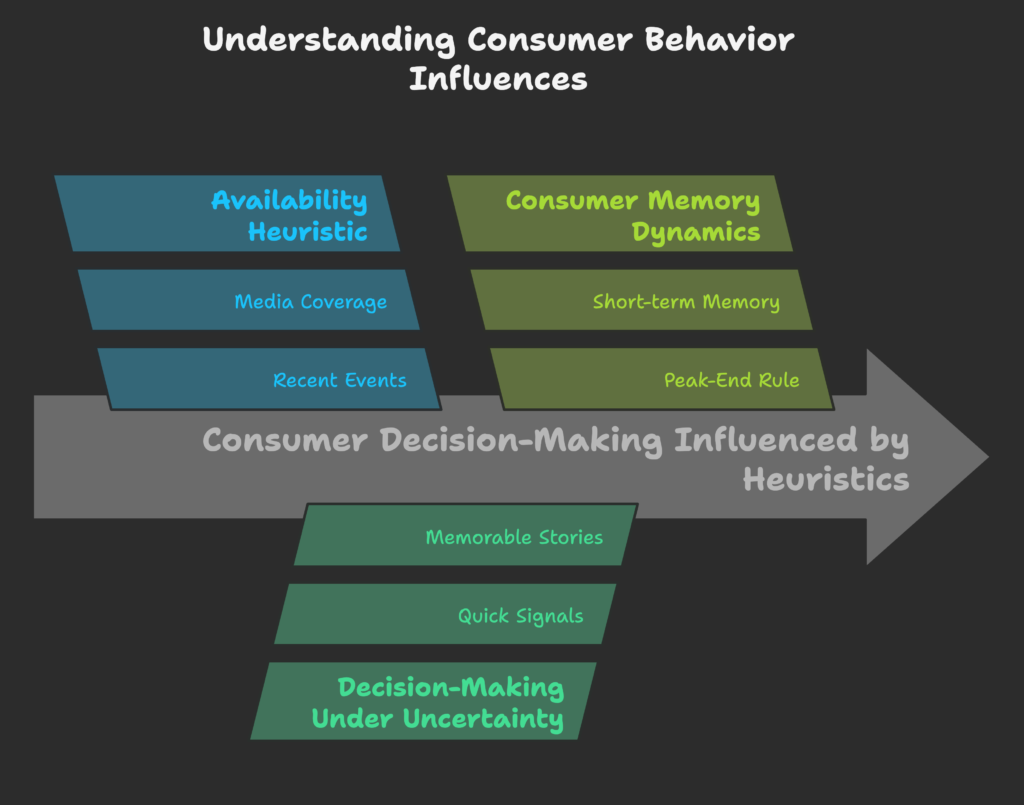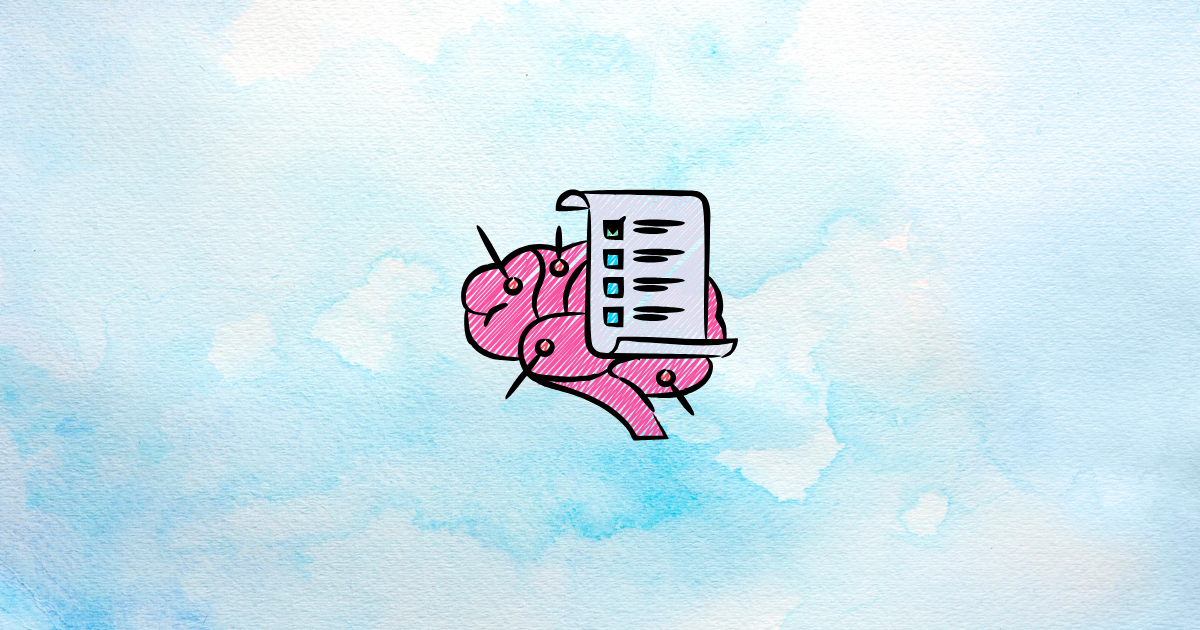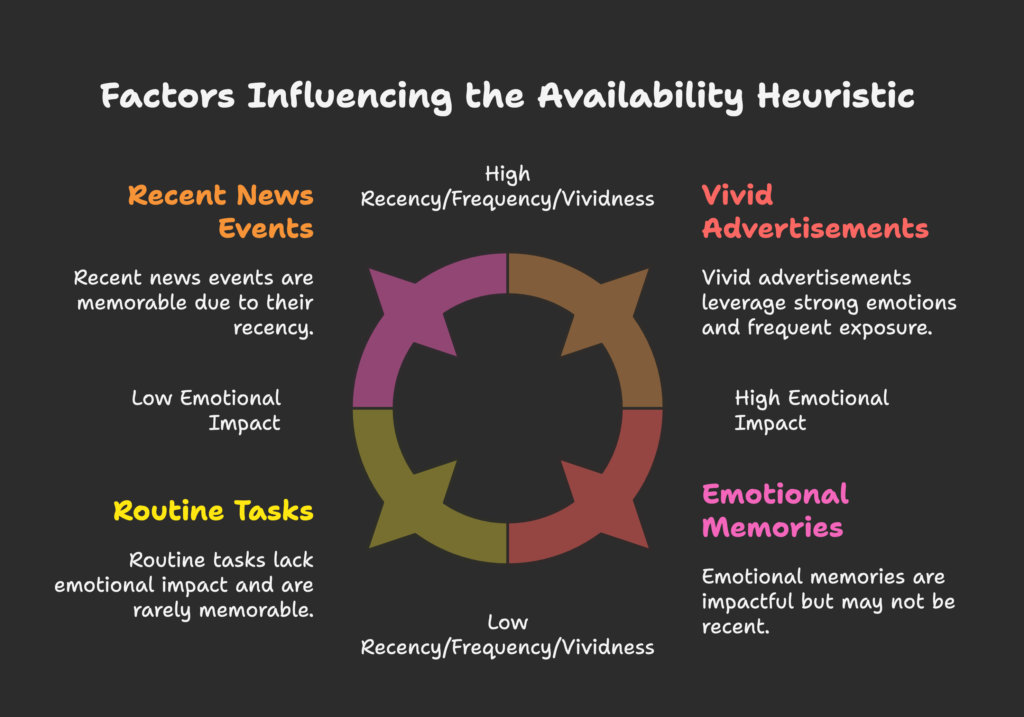Did you ever notice how a single dramatic event can shape your decisions for weeks afterward? Maybe you saw a glowing review of a product on social media, and suddenly you couldn’t stop thinking about it. Or perhaps you heard one alarming story about a certain service, and now you’re convinced it’s too risky. This tendency to rely on the most recently available information is known as the availability heuristic.
In this article, you’re going to discover exactly how our minds use recent and vivid experiences to shape our choices—especially our buying decisions. You’ll learn the psychology behind the availability heuristic, see how it influences consumer behavior, and find out what businesses can do to use (and not abuse) this mental shortcut. Ready to explore the secrets behind why those memorable moments stick in our heads? Let’s dive in!
Introduction to the Availability Heuristic
Definition and Conceptual Framework
The availability heuristic is a mental shortcut that leads us to judge the probability or frequency of something based on how easily we can recall examples of it. Proposed by Amos Tversky and Daniel Kahneman, this concept grew from the recognition that our minds often rely on quick retrieval of memories to form opinions and make decisions. When information is fresh or vivid in our minds, we perceive it as more likely or more important than it might actually be.
Imagine you recently heard about a new phone that exploded on rare occasions. Even though such an event is extremely uncommon, that one dramatic example can heavily influence your perception of the product’s safety. This is the availability heuristic at work.
So far: We’ve introduced the core idea of availability. Next, we’ll explore the fascinating psychology behind mental availability. Don’t miss out!
The Psychological Foundations of Mental Availability
Behind the availability heuristic lies a set of cognitive processes that link memory retrieval to our sense of probability. When something is easy to recall, our brains interpret that memory as a sign of importance or frequency. This is closely related to what researchers call System 1 thinking—our fast, automatic, and intuitive thought process.
In contrast, System 2 thinking is more analytical and slow. However, in many day-to-day situations—like deciding which product to buy—System 1 often dominates. This means our brains rely on quick judgments rather than slow analysis. If a recent or emotional event is easy to recall, it feels like a more common event than it may truly be.
We’ve seen the foundations: Now let’s look at how consumer decision-making evolved from purely rational models to an understanding of these cognitive biases. Ready?
The Evolution of Understanding Consumer Decision-Making
Early economic theories often viewed consumers as rational agents who always make the best possible decisions. Yet, as behavioral economics developed, it became clear that cognitive biases, like the availability heuristic, drive many “irrational” choices. Because of these biases, consumers often rely on whatever information is most mentally accessible.
This understanding has huge economic implications. It explains why certain products fly off the shelves after a single viral video, or why a serious but rare product malfunction can harm sales for a long time. As we’ve recognized these influences, companies have started to adapt marketing strategies to align with how people naturally think.
Keep reading: Let’s dive deeper into the theoretical roots behind the availability heuristic. You’re about to discover how memory and perception go hand in hand!
Theoretical Foundations of the Availability Heuristic
Cognitive Science Perspectives
From a cognitive science viewpoint, the ease with which we remember something depends on factors like attention, encoding, and retrieval. When we pay close attention to an event, we encode it more strongly, making it more “available” later on. This explains why advertisements focusing on bright images or strong emotions tend to stick in our minds.
Another key idea is the difference between automatic and deliberative processing. Automatic processes require little effort and are often guided by emotions or immediate judgments, while deliberative processes require more conscious thought. Because we prefer mental shortcuts, our decisions frequently stem from the automatic side.
Up next: Let’s see how emotional factors, recency, frequency, and vividness all play a part in making certain memories stand out!
Psychological Mechanisms Underlying the Availability Heuristic
Our emotions significantly shape what we remember. If an event is funny, scary, or heartwarming, it anchors itself more deeply into our memory. Recency also matters—something that happened yesterday is much easier to recall than an event from a year ago. Frequent repetition of an idea, product, or brand can push it to the forefront of your mind, making it feel more familiar and thus more likely to be chosen.
Vividness is another driver. Bold visuals, captivating stories, or striking headlines leave a strong impression. If you see a shocking headline about a food product recall, you might judge that brand as riskier, even if the recall was a one-time issue.
Ready for more? Let’s look at how these mechanisms relate to other mental shortcuts like representativeness or anchoring. The web of cognitive biases is truly fascinating!
Related Cognitive Biases and Heuristics
The representativeness heuristic often interacts with availability by encouraging us to judge things based on stereotypes or examples we can easily recall. Anchoring is another bias where an initial piece of information shapes later judgments, often tying closely with how available that anchor is in our memory. There’s also the conjunction fallacy, where people assume multiple specific events are more likely than a single general event—especially if vivid information is available. And of course, confirmation bias can make us focus on information that fits what we already believe, reinforcing whatever is most available in our thoughts.
Onward: Now that we’ve explored the theoretical groundwork, let’s see how availability plays a huge role in everyday consumer behavior!
The Availability Heuristic in Consumer Behavior

How Recent Events Shape Consumer Perception
Consumers rely heavily on whatever is top of mind when making a purchase. A recent positive review can overshadow older negative feedback. Media coverage or word-of-mouth can skyrocket a brand into the public eye—or ruin it just as quickly. This is why crisis events often hurt companies so much: everyone remembers the latest bad news. Even if the issue is rare, the availability of that information makes the product seem untrustworthy.
But there’s more: We also need to consider how consumers make decisions when facing uncertainty. Let’s check that out next!
Decision-Making Under Uncertainty
When customers are unsure, they look for quick signals to guide them. Maybe the only “signal” is a memorable news story or a friend’s opinion. That mental shortcut can affect the consumer’s price sensitivity, product category choices, and overall satisfaction. If an expensive item is the first thing that comes to mind—because of a recent ad—it might become the main comparison point, anchoring all subsequent judgments about price.
Curious about memory dynamics? Let’s dig in to see how short-term and long-term memories drive these decisions over time.
Consumer Memory Dynamics
Short-term memory is powerful but fleeting. If someone sees a product ad and quickly visits the store, the recentness of that ad will likely guide the purchase. Over time, though, memories fade. Brands can use methods like the peak-end rule—where the most intense point of an experience and its ending are what people remember best—to ensure consumers recall positive moments. The more vivid and emotionally charged the experience, the longer it stays available in the consumer’s mind.
Ready to see some real-world data? Let’s explore how research has proven these concepts in action!
Empirical Evidence of the Availability Heuristic in Purchase Decisions
Research Findings in Consumer Psychology
In controlled experiments, participants often base their choices on the first memory they can retrieve, even if that memory is an outlier. Field studies confirm that hype or fear sparked by a single event can drastically influence sales. Cross-cultural research also suggests that while the intensity of the effect may vary, the availability heuristic is universal in shaping consumer decisions. Some people, due to personality or upbringing, may be more prone to availability bias, but nobody is immune.
But how do these findings look in real-life cases? Let’s see some concrete examples next!
Case Studies of Availability-Driven Consumer Choices
- Brand Selection After Recent Ads: Many people choose a brand they’ve seen advertised only a day before, ignoring other options they’ve never heard about.
- Safety Concerns: After a well-publicized recall or malfunction, even safe brands can suffer if customers recall the negative press.
- Natural Disasters: Storms and floods often trigger a rush for emergency supplies, because dramatic images of damage remain top of mind.
- Celebrity Influence: People often buy outfits they’ve seen on celebrities just because that image is still fresh in their heads.
Next up: Let’s look at the tools researchers use to measure these availability effects. That will give you a sense of how professionals assess and understand this bias.
Measurement and Assessment Methods
Measuring availability bias involves both qualitative and quantitative techniques, such as surveys where respondents list the first products they think of, experimental setups where recall times are tracked, and even neuroimaging to see which brain regions activate when recalling certain brands or events.
We know the evidence is strong: How can marketers make practical use of it? Let’s find out!
Marketing Applications of the Availability Heuristic
Strategic Brand Visibility
Marketing teams aim to keep their brands at the forefront of consumers’ minds. This involves consistent exposure on social media, in-store displays, and even iconic logos or slogans that people quickly recall. Distinctive assets—like a unique brand color or mascot—can reinforce mental availability, making a product the go-to choice at the moment of decision.
Moving on: Let’s see how advertisements can be crafted to boost availability in even more memorable ways.
Advertising and Communication Strategies
Ads that stir emotions (laughter, empathy, excitement) are more memorable. Repetition also helps, though it needs to be balanced to avoid annoying consumers. Strategically timed messages—like showcasing warm drinks in winter—capitalize on seasonally available information in consumers’ minds. Emotional content plus the right timing can significantly heighten brand recall.
Curious about product positioning? Let’s see how companies align their offerings with what’s top of mind for consumers.
Product and Service Positioning
A product that fits a clear, vivid need is more likely to be remembered. Businesses that design memorable experiences—like an interactive in-store demo—also benefit from the availability heuristic, because customers more easily recall strong experiences. Aligning a new product with an existing mental framework (e.g., eco-friendly, convenient, premium) can also boost mental accessibility.
Ready for practical tips? Next, we’ll explore how companies can use these insights in real-world business strategies.
Practical Applications for Businesses
Retail and E-commerce Strategies
In-store design can guide the shopper’s journey so that certain items are seen first or most frequently. Online, well-placed “featured” sections or reminders can keep products at the front of a customer’s mind. Ensuring a smooth, memorable checkout experience also helps customers recall their positive experiences, leading to repeat visits. Post-purchase emails or messages can maintain that availability even after the purchase.
Up next: Let’s see what happens when a brand faces a crisis and how availability can be both a challenge and an opportunity.
Brand Management in Crisis Situations
Bad news travels fast, and it often sticks in people’s minds longer than good news. For brands that face negative publicity, quick and transparent crisis communication can reduce the availability of harmful stories. If businesses respond effectively, they can replace scary images or headlines with positive or reassuring information. Over time, this reframing helps people recall the brand’s solution rather than the initial crisis.
Time to innovate: Let’s explore how new product launches can harness availability from day one.
Product Launch and Innovation
When introducing a new product, businesses can create a sense of immediacy by teasing features and benefits well before launch. Frequent touchpoints—like sneak previews or beta tests—keep the product mentally available. If a brand has a history of product failures, it needs to offset the negative availability by showcasing fresh success stories and user testimonials.
Next step: Let’s consider some ethical questions that arise when using these tactics. Marketing should influence—not manipulate.
Ethical Considerations and Consumer Protection
Potential for Manipulation in Marketing
Using the availability heuristic can be a fine line between influencing and manipulating. Marketers must be aware that repeatedly showing disturbing or highly emotional ads might pressure consumers into decisions they wouldn’t otherwise make. Regulatory bodies often watch for misleading tactics that exploit the public’s memories in unfair ways.
What about the consumers’ side? Let’s see how education can protect them.
Consumer Education and Awareness
When consumers understand how availability influences them, they can pause and question their instincts. Encouraging people to seek multiple perspectives or wait a day before making a big purchase can reduce impulsive, availability-driven decisions. Media literacy training also helps consumers identify sensational headlines and avoid being overly swayed by them.
Looking beyond profit: Let’s see how companies can behave responsibly while still using these insights.
Corporate Social Responsibility
Brands that respect the power of cognitive biases strive to build trust by being transparent and fair. They realize that short-term gains from manipulative tactics can damage long-term relationships. A socially responsible company balances the use of mental shortcuts with genuine value creation, ensuring customers feel confident in their choices.
Now: Let’s turn our attention to the future and how our digital world might change availability mechanisms.
Future Trends and Emerging Research
Digital Media and New Forms of Availability
Constant notifications, personalized feeds, and viral social media trends all amplify the availability heuristic. In the digital world, what’s trending can quickly become the only thing people talk about. Younger generations, in particular, live in an environment of nonstop updates, so researchers are asking whether the availability heuristic becomes even stronger when we’re all so hyper-connected.
Next: How do other fields contribute to this discussion?
Cross-disciplinary Research Directions
Neuroscience is uncovering the brain patterns tied to availability, while machine learning models can predict which ads will be most memorable. Behavioral economics looks at how these insights shape policy, ensuring fair marketing practices. Each discipline adds new layers of understanding to how availability guides consumer behavior.
Finally: Let’s see how evolving consumer environments might reshape this heuristic over time.
Evolving Consumer Environments
As AI assistants and recommendation engines become more prevalent, the availability of certain information can become automated by algorithms. This could either help consumers by suggesting well-reviewed products or further narrow their perspectives by repeatedly showing the same options. Culture itself evolves, so what feels vivid or important can shift across different societies and markets.
Ready for the final stretch? Let’s see how to put these ideas into action with concrete strategies.
Practical Implementation Strategies
Marketing Campaign Design
To create campaigns that stick, marketers should focus on memorable stories, compelling visuals, and strategic repetition. They should also measure how often consumers recall their ads to gauge effectiveness. One approach is A/B testing different messages and seeing which ones stay top of mind.
On to customer experience: Let’s see how designing memorable touchpoints can keep your brand at the forefront.
Customer Experience Management
Every customer interaction—from the website layout to post-purchase support—can reinforce positive availability. Surprise gifts, personalized messages, or follow-up calls all create emotional moments that consumers recall easily. If a service issue arises, resolving it quickly and with empathy transforms a negative memory into a positive one.
Now let’s go digital: Time to see how online content can keep you top of mind.
Digital Presence and Content Strategy
Online content that is “sticky”—meaning it captures attention and sparks emotional engagement—is more likely to be recalled. SEO (Search Engine Optimization) efforts also play a role: if your brand appears first in search results, it becomes the most easily available option. Meanwhile, social media posts timed for when your audience is most active can amplify the chance that your message is fresh in their minds.
We’re almost done: Let’s tie everything together in our conclusion, with strategic recommendations and final insights!
Conclusion and Strategic Recommendations
Synthesis of Key Insights
The availability heuristic is a powerful mental shortcut that influences everything from the clothes we buy to the services we trust. By understanding how recent, vivid, and emotionally charged information shapes decisions, businesses can craft more effective marketing strategies. However, with great power comes responsibility—ethical considerations must remain front and center.
But what does the research tell us specifically?
Research-Based Recommendations
- Create frequent, positive touchpoints: Keep your brand accessible in a consumer’s memory.
- Use emotional or vivid elements: Make your messaging stand out and be easily recalled.
- Balance influence with ethics: Avoid fear-based strategies that might harm long-term trust.
- Adapt to changing technologies: Stay aware of how AI and social media shift consumer attention.
One last thought: Let’s wrap up with a final perspective on the importance of blending genuine value with psychology.
Final Perspectives on the Availability Heuristic
In a world overflowing with information, the availability heuristic will continue to guide countless consumer decisions. Businesses that respect its power while focusing on authenticity can thrive, building lasting trust and loyalty. Ultimately, understanding the availability heuristic is about recognizing the delicate balance between how people naturally think and what they genuinely need.
Before you go: If you have a Shopify store and want to boost your sales even further, consider using Growth Suite—it’s designed to simplify your marketing efforts and keep your products top of mind for your customers.
References
- Adcock Solutions. (2024, August 6). The Availability Heuristic. https://www.adcocksolutions.com/post/the-availability-heuristic
- Alpha Diver. (2024, May 31). Unlocking Buying Decisions: Key Heuristics Explored. https://alpha-diver.com/5-key-heuristics-affecting-buying-decisions/
- Explorer Research. (2024, November 4). Heuristics and Shopper Behavior in Market Research – Part 1. https://explorerresearch.com/heuristics-and-shopper-behavior/
- FasterCapital. (n.d.). The Role Of Availability Heuristic In Consumer Choices. https://fastercapital.com/topics/the-role-of-availability-heuristic-in-consumer-choices.html
- LimeHub. (2024, June 19). The Availability Heuristic: Capitalising on Top-of-Mind Awareness. https://www.limehub.com.au/blog/the-availability-heuristic-capitalising-on-top-of-mind-awareness
- Researcher.Life. (2024, October 3). What is Availability Heuristic (with Examples). https://researcher.life/blog/article/what-is-availability-heuristic-with-examples/
- Stephenson, A. (2019, July 9). Heuristics and Shopper Behavior. LinkedIn. https://www.linkedin.com/pulse/heuristics-shopper-behavior-anne-stephenson
- The Decision Lab. (2021, October 11). Availability Heuristic. https://thedecisionlab.com/biases/availability-heuristic
- Tversky, A., & Kahneman, D. (1973). Availability: A heuristic for judging frequency and probability. Cognitive Psychology, 5(2), 207-232.
- Zhang, Z. (2004). Availability of Heuristic Marketing Psychology. Atlantis Press. https://www.atlantis-press.com/article/125971349.pdf





